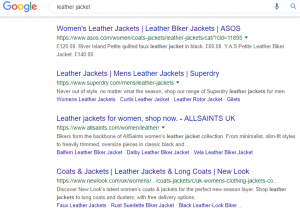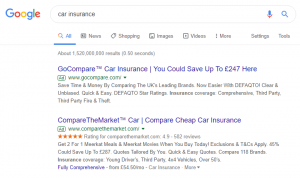Nailing your ad copy is a crucial element of creating a Google Ad. Even if you’ve perfected your keywords, negatives and landing page, if your ad copy isn’t up to scratch, you could be limiting your success.
When you’re just getting started with Google Ads, it’s easy to start overthinking your copywriting, but it needn’t be too complicated! If you think your ad copy might be holding you back, we’ve put together some advice to boost your results. So before you jump into the creative stuff, let’s quickly review the search ad format.
Character limits
First things first, how many characters do you have to work with?
Headlines
In an expanded text ad, you can include up to 3 headlines. These can include a maximum of 30 characters each. Your first and second headlines will always be shown in search results, whereas your third will sometimes be shown. Usually, third headlines are shown mostly on mobile.
Your key information should be included in your first and second headings. In the first, make sure you include your keywords, and try to use a call-to-action in the second. The third headline is another opportunity to share worthwhile information. This can be used as a ‘trust builder’ to add credibility. Do you have years of experience or an impressive amount of good reviews? This is your chance to brag!
Descriptions
You can have 2 descriptions, both with a 90 character limit. However, just as your third headline isn’t always shown, neither is your second description. Your first description is certain to be shown, whereas your second will mostly be shown on mobile searches.
Your key information needs to be included in your first description, as do your keywords. Although your second description won’t always be displayed, it provides a good opportunity to provide additional information and add credibility.
The key takeaway here is that you’re very limited on characters, which leads us to our next point…
Use your characters wisely
You might have a lot to say, but there’s no room for babble!
When you complete a search, how often do you read through every bit of information in the first page of search results? Never, right? Users don’t spend hours trawling through search results; they want answers quickly. People tend to skim read, so you need to quickly capture their attention.
Consider your keywords, and what your target audience is looking for. If you provide a great budget product, then users who include ‘cheap’ in their search term might be more inclined to click on your ad if you include the price, or a term such as ‘budget’ in your ad copy. Someone searching for ‘luxury gyms’ might be interested in the facilities you have, so you could include some brief information on your newest equipment.
Create copy that’s specific to each ad
Once you’ve created some great ad copy, it might seem sensible to use it in all your ads. Although this might save you time, it’s not the way to achieve results.
Once you’ve divided your products into categories (usually in the same way that they’re organised on your website), you should produce copy for each ad. If you sell shoes, for example, you could separate your products into trainers, leather shoes, high-heels etc. This way, you can group your keywords together and write copy for each specific product.
Highlight your USP
To write persuasive copy, you need to get into your customers’ heads. What is it that makes your product or service unique? Are you particularly cheap, or do you provide especially good quality? Maybe you provide free delivery or a 12 month guarantee.
In your ad, your value proposition should be immediately clear. Put yourself in your customers’ shoes. What do they stand to gain that will draw their attention?
In truth, having written and reviewed the performance too many ads over the years, it’s the same old techniques that really work. Sales work well, particularly if it’s a big discount. I.e ‘Sale Up To 60% Off.’
The best performing ad we ever wrote was for a client whose competitor ran an ad for up to 78% off. We suggested he run an ad for up to 80% off. Weirdly, we now owned the 80% off spot and made the 78% off seem weak. Now, 80% off just seems unbelievable, but the results? Our client became the largest supplier of online fire extinguishers in the UK on the back of this single ad.
It’s the DFS approach. No intelligent person really believes that DFS have a sale – after all, there’s always a sale! But our brains don’t work that way when responding to adverts. We’re naturally drawn to a product or service when it seems like a bargain. Often, we can’t resist something when we feel that we’re getting it at an especially good price. There’s a bargain hunter in all of us!
Here’s some ideas for eye-catching headlines:
| Sale! |
| Sale Ends Soon! |
| Today Only! |
| Just (£?) |
| Only (£?) |
| From (£?) Delivered |
| Low Prices |
| Cheap |
| Lowest Ever |
| Clearance |
| 60% off (product) |
| 80% Off RRP |
| Sale on (product) |
| Our Biggest Ever Sale |
| Our Biggest Ever Spring Sale |
| Mega Savings |
| Mega Savings Upto (70%) |
| Huge Sale Now On |
| Bargain Product Prices |
| Bargains |
| Affordable |
| Save (£) on (product) |
| Why Pay More? |
| Upto £200 Off {Product} |
| Great Deals on {product} |
| Great Deals on New {product} |
Your USP may be a delivery option including sameday or next day delivery. If you’re selling furniture, for example, you might offer to deliver, assemble and take away the packaging. Mattress suppliers, for example, often use a 100 night trial.
Whatever it is that makes you more attractive than your prospects, you should include it in your ad text. Make sure it’s simple and able to be quickly digested by the user.
If you’ve won an award or provide exceptional customer service, you can use these to add credibility. Awards and celebrity endorsements are interesting in their own right. People don’t like making decisions, so if someone who we trust makes a buying choice, our buying decision becomes easier.
Don’t forget your keywords
Remember to include your keywords in your ad copy. When a user searches for ‘leather jacket’, they’ll naturally gravitate towards results that include this term. Google actually displays this term in bold (see below), so they become more prominent. You should try to include your keywords in your first headline and your description.
By using your keywords in your ad copy, you improve the ad’s relevance, which, in turn, improves quality score. Your ads’ placement in search results is calculated by multiplying the ad quality score by your maximum bid per click. So;
Ad rank = quality score X maximum bid per click
Your ad’s relevance to your keywords is one of several factors that impact your quality score. So, if you don’t use your keywords in your ad text, it’ll negatively impact your quality score, and you’ll find yourself having to spend more to stay in those top spots.
Creativity is important, but make sure you don’t get so carried away in creating interesting ad copy that you forget your keywords!
Include a call-to-action
The lesson we take from traditional marketing methods, such as newspaper ads or direct mail, is that you need to tell the customer what to do. Research has shown that when the advertiser tells the customer what action they need them to do, sales are significantly higher.
When you include a call-to-action, your customer knows exactly what you expect from them next. A clear CTA, such as ‘shop now’ or ‘start saving money now’, also gives a good indication of what can be found on your landing page. Your CTA depends on your offering. If you’re not sure what it should be, consider why a customer should visit your site and what their next step is. Some good examples include ‘Speak to our expert team’, ‘Get a free quote’ or ‘Explore our range today’.
In the screenshot above, both ads use CTAs. The first ad places their CTA – ‘Save Time & Money By Comparing The UK’s Leading Brands’ in their description. The second ad puts their CTA in the headline. ‘Compare Cheap Car Insurance’ is a very clear direction, and the user knows exactly what to expect from the landing page.
DON’T copy
When your competitors are doing well, of course you want to replicate their success, and it can be tempting to use their ideas. After all, they must be doing something right!
Competitor research is worthwhile, and there’s no harm in taking inspiration, but be careful not to copy. If you create an ad that’s a word-for-word replica of someone else’s, that’s pretty blatant copying and could land you in hot water.
A technique we often advise is to search other industries and see what techniques they’re using. As a large portion of our clients are US based, we have taken inspiration from US advertisers and use the top advertisers’ techniques in the UK. Surprisingly, the US is not as price-competitive as the UK. We’re world leaders in cut-throat pricing online.
In summary, celebrate your USPs and make sure you stand out.
Read and reread
Once you’ve created your ad copy, make sure you thoroughly check through it. Spelling mistakes, missing capitals or sentences that don’t make sense can make you appear unprofessional. You don’t get a second chance at a first impression!
Think about your display URL
This is essentially a ‘false’ URL. The first part of the URL remains as your usual domain name, but you are able to rewrite the latter section. You can use this to create a URL that’s specific to the user’s search.
Landing page
As discussed previously, quality score is based on keywords, adverts, landing page and ad extensions. Make sure your landing page relates as closely as possible to your keywords and ad text. This increases quality score and reduces click cost.
Once you’ve built your ad, click the blue headline and ensure it takes you to the correct landing page. This only takes a second but is a vital thing to check. You don’t want to find that you’ve been sending users to the wrong landing page!
Test, test, test
Your ads should continually evolve as you discover the techniques that bring the best results. Even if your ads appear to be running successfully, carrying out tests is worthwhile to discover where improvements can be made. When you’re testing, try one change at a time. This way, you can be sure exactly what effect each change has.
Here a few suggestions of tests you can carry out:
- Test your headlines – create a few versions and monitor the conversion rate for each. Click-through-rate is important, but do make sure that a higher CTR is also leading to higher conversions.
- Try out different offers – does a ‘£50 off’ offer work better than ‘20% off’?
- Check which strengths to show off – if you’ve got several that you’re proud about, check which are most desired by users. Your 12 month guarantee might be more enticing than your free delivery, for example.Finally, we would always urge you to get specialist help to ‘short cut’ your learning curve. Whilst it seems everyone is a marketing expert these days, or is using some automation to gloss over the basics, focusing on the basics is important to gain a better understanding. We get extraordinary results, but the truth is we just apply good direct response marketing sense – keywords, negatives, ad copy, bidding.
Would you benefit from the advice of Google Ads professionals? Contact us below for a free review.

